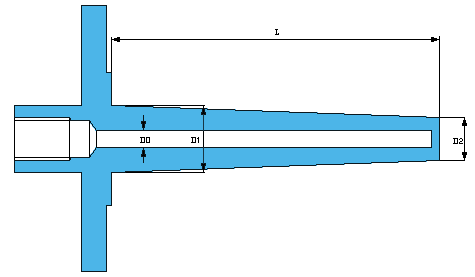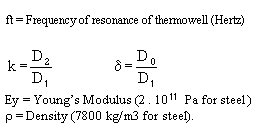Thermowell resonance
Thermowells have been known to fail due to induced vibrations from the
fluid flowing past it. The problem is in general confined to the flow of
gases as their high velocities lead to higher vortex shedding
frequencies and the low mass and viscosities do not provide any damping
to the thermowells.
In general, if this phenomenon is likely to happen, you should design
the thermowell in such a way that the maximum Strouhal frequency (fs) is
not higher than 70% or 75% of the thermowell natural resonance frequency
(ft).
Our problem is the determination of the natural resonance frequency and
to this end I propose the formula below. If it looks complicated I
apologise, but I wanted to know what it was for tapered thermowells
hence the added complications (and if you think that's complicated, you
ought to see the rest of the calculations).
I should also mention the contribution from Lloyd Williams-Wynn to whom
I gave the ungrateful task of checking the maths and who picked up the
deliberate error I had left in the middle (well OK , I admit it was not
deliberate) and who, despite all this, still remains on talking terms
with me.
Thermowells Natural Frequency - 1st Mode of
Vibration
 |
Strouhal Frequency
The vortex shedding frequency is a function of the Strouhal
number, Ns, which is defined as :
Ns = fs.D/V
Where fs is the shedding frequency, D is the
diameter, V is the fluid velocity.
Ns is relatively constant over a large range of Reynolds numbers
(hence the reason why vortex meters exist).
Perry's Chemical Engineering Handbook reads:
Ns=0.19 for all Re between 500 & 10000 (Refer 5-181 page
5-55 5th Edition)
|
 |
 |
The formula has been calculated by Rayleigh's approximation method. It
is expected that the answer will not exceed the true frequency of
resonance by more than one or two percent.
It has been compared with the theoretical value for a parallel
thermowell and the agreement was better than 0.1% .
Those interested in the derivation of the formula can collect
a zip file containing a copy of the source
documents (PDF) plus a bonus Excel 5.0 spreadsheet.
Whilst every care was taken when calculating the above formula, the
author (who developed the formula during a period of residency at a
lunatics' asylum) assumes no responsibility for the information
contained herein.
IT'S A HARD LIFE !
Other relevant information:
A comparison of the frequency formula against the results of a
finite element analysis program has confirmed that the error in
frequency is no higher than 2%. Contact
David Bartran for more
information.
Design to a known standard:
John Dusting Technologies Pty Ltd
1246 Stumpy Gully Rd
Moorooduc, Vic, 3933
tel: (03) 5978 8033
fax: (03) 5978 8044
Email
jdusting@bigpond.com
Will be happy to design your thermowells to the latest ASME Standard
PTC19.3
 Return
Return



 Return
Return